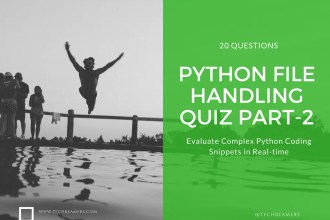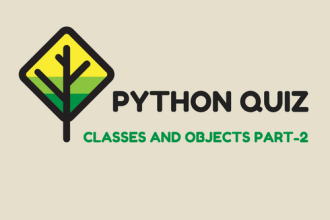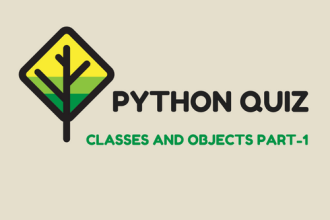Hey, there experienced Python programmers, are you ready to test your skills with our Python Functions Quiz Part-2? This quiz features 21 medium to high-complexity questions that will put your knowledge to the test. But before you dive in, let’s talk about the importance of functions in Python.
Functions are a powerful tool that helps organize your code into logical blocks, making it easier to read, modularize, and reusable. They are also a great way to create interfaces for other programmers.
Take on our Advance Level Python Functions Quiz Part-2
Did you know that in Python, functions can return multiple values? It’s true! Return the results as a tuple. And if you ever need to list down the functions of a module, you can use the <getmembers()> method of the <inspect> module. So, if you’re up for a challenge, take our Python Functions Quiz Part-2 now. Good luck and have fun!
Q-1. What is the output of the following code snippet?
def func( mylist ):
"This changes a passed list into this function"
mylist = [1,2,3,4]; # This would assign new reference in mylist
print ("Values inside the function: ", mylist)
return
mylist = [10,20,30];
func( mylist );
print ("Values outside the function: ", mylist)A. Values inside the function: [1, 2, 3, 4]
Values outside the function: [10, 20, 30]
B. Values inside the function: [10, 20, 30]
Values outside the function: [10, 20, 30]
C. Values inside the function: [1, 2, 3, 4]
Values outside the function: [1, 2, 3, 4]
D. None of the above
Show Answer
Option – A
Q-2. What is the output of the following code snippet?
x = 50
def func():
global x
print('x is', x)
x = 2
print('Changed global x to', x)
func()
print('The value of x is', x)A. x is 50
Changed global x to 2
The value of x is 50
B. x is 50
Changed global x to 2
The value of x is 2
C. x is 50
Changed global x to 50
The value of x is 50
D. None of the mentioned
Show Answer
Option – B
Q-3.Which of the following function calls can be used to invoke the below function definition?
def test(a, b, c, d)
A. test(1, 2, 3, 4)
B. test(a = 1, 2, 3, 4)
C. test(a = 1, b = 2, c = 3, 4)
D. test(a = 1, b = 2, c = 3, d = 4)
E. test(1, 2, 3, d = 4)
Show Answer
Option – A, D, and E (Note: B and C lead to SyntaxError: positional argument follows keyword argument.)
Q-4. What is the output of the following code snippet?
def test(a, b=5, c=10):
print('a is', a, 'and b is', b, 'and c is', c)
test(3, 7)
test(25, c = 24)
test(c = 50, a = 100)A. a is 7 and b is 3 and c is 10
a is 25 and b is 5 and c is 24
a is 5 and b is 100 and c is 50
B. a is 3 and b is 7 and c is 10
a is 5 and b is 25 and c is 24
a is 50 and b is 100 and c is 5
C. a is 3 and b is 7 and c is 10
a is 25 and b is 5 and c is 24
a is 100 and b is 5 and c is 50
D. None of the above
Show Answer
Option – C
Q-5. What is the value of num after the function call?
def myfunc(text, num):
while num > 0:
num = num - 1
num=4
myfunc('Hello', num)A. 4
B. 3
C. 0
D. 1
Show Answer
Option – A
Q-6. What is the output of the following code snippet?
def func(x = 1, y = 2):
return x + y, x - y
x, y = func(y = 2, x = 1)
print(x, y)A. 1 3
B. 3 1
C. The program has a runtime error because the function returns the multiple values
D. 3 -1
E. -1 3
Show Answer
Option – D
Q-7. What is the output of the following code snippet?
def func():
text = 'Welcome'
name = (lambda x:text + ' ' + x)
return name
msg = func()
print(msg('All'))A. Welcome All
B. All Welcome
C. All
D. Welcome
Show Answer
Option – A
Q-8. What is the output of the following code snippet?
min = (lambda x, y: x if x < y else y) print(min(101*99, 102*98))
A. 9997
B. 9999
C. 9996
D. 9998
Show Answer
Option – C
Q-9. What is the output of the following code snippet?
def func(x, y=2):
num = 1
for i in range(y):
num = num * x
return num
print (func(4))
print (func(4, 4))A. 8 16
B. 16 256
C. 32 1024
D. 128 1256
Show Answer
Option – B
Q-10. What is the output of the following code snippet?
def add(*args):
'''The function returns the addition
of all values'''
r = 0
for i in args:
r += i
return r
print (add.__doc__)
print (add(1, 2, 3))
print (add(1, 2, 3, 4, 5))A. The function returns the addition of all values
6 15
B. 6 15
C. 123 12345
D. 6 120
Show Answer
Option – A
Q-11. What is the output of the following code snippet?
def addFunc(item):
item += [1]
mylist = [1, 2, 3, 4]
addFunc(mylist)
print (len(mylist))A. 2
B. 4
C. 5
D. An exception is thrown
Show Answer
Option – C
Q-12. What is the output of the following code snippet?
def heading(str):
print ("+++%s+++" % str)
heading.id = 1
heading.text = "Python functions"
heading("%d %s" % (heading.id, heading.text))A. +++%s+++
B. Python functions
C. +++Python functions+++
D. +++1 Python functions+++
Show Answer
Option – D
Q-13. What is the order of usage of *args, **kwargs, and formal args in the function header?
A. some_func(formal_args, *args, kwargs)
B. some_func(kwargs, *args, formal_args)
C. some_func(*args, *kwargs, formal_args)
D. some_func(args, formal_args, **kwargs)
Show Answer
Option – A
Q-14. What is the output of the following code snippet?
def test_var_args(param1, *args):
print (type(args))
test_var_args('delhi', 'noida', 'gurgaon', 'ghaziabad')A. str
B. int
C. tuple
D. list
E. dict
Show Answer
Option – C
Q-15. What is the output of the following code snippet?
def test_var_args(param1, **kwargs):
print (type(kwargs))
test_var_args('capitals', India='New Delhi',
Australia='Canberra', China='Beijing')A. str
B. int
C. tuple
D. list
E. dict
Show Answer
Option – E
Q-16. What is the output of the following code snippet?
def test_var_args(farg, *args):
print ("formal arg:", farg)
for arg in args:
print ("another arg:", arg)
test_var_args(1, "two", 3)A. formal arg: 1
another arg: two
another arg: 3
B. formal arg: 1
another arg: two
C. An exception is thrown
D. None of the above
Show Answer
Option – A
Q-17. What is the output of the following code snippet?
def test_var_kwargs(farg, **kwargs):
print ("formal arg:", farg)
for key in kwargs:
print ("another keyword arg: %s: %s" % (key, kwargs[key]))
test_var_kwargs(farg=1, myarg2="two", myarg3=3)A. formal arg: 1
another keyword arg: myarg2: two
another keyword arg: myarg3: 3
B. formal arg: 1
another keyword arg: myarg2: two
C. An exception is thrown
D. None of the above
Show Answer
Option – A
Q-18. What is the output of the following code snippet?
myList = [1, 2, 3, 4, 5]
def func(x):
x.pop()
x.pop()
x.insert(-1, 0)
print ("Inside func():", x)
func(myList)
print ("After the function call:", myList)A. Inside func(): [1, 2, 3, 0]
After the function call: [1, 2, 3, 4, 5]
B. Inside func(): [0, 1, 2, 3]
After the function call: [0, 1, 2, 3]
C. Inside func(): [1, 2, 3, 0]
After the function call: [1, 2, 3, 0]
D. Inside func(): [1, 2, 0, 3]
After function call: [1, 2, 0, 3]
Show Answer
Option – D
Q-19. What is the output of the following code snippet?
nums = range(2, 50)
for i in range(2, 8):
nums = list(filter(lambda x: x == i or x % i, nums))
print (nums)A. [2, 3, 4, 5, 6, 7, 8]
B. [2, 3, 5, 7, 11, 13, 17, 19, 23, 29, 31, 37, 41, 43, 47]
C. [2, 3, 5, 6, 7, 10, 15, 19, 20, 27, 35, 41, 49]
D. [2, 3, 5, 9, 13, 17, 26, 31, 35, 37, 41, 43, 47, 49]
Show Answer
Option – B
Q-20. What is the output of the following code snippet?
text = 'Welcome to the world of Python' words = text.split() length = list(map(lambda word: len(word), words)) print (length)
A. [7, 2, 3, 5, 2, 6]
B. [30]
C. [7, 3, 4, 5, 6, 3]
D. [30, 23, 20, 15, 13, 7]
Show Answer
Option – A
Q-21. What is the output of the following code snippet?
from functools import reduce f = lambda a,b: a if (a > b) else b num = reduce(f, [47,11,42,102,13]) print (num)
A. 47
B. 42
C. 102
D. 11
Show Answer
Option – C
Level Up Your Python Function Skills with Our Quiz
Congratulations on completing the Python Functions Quiz Part-2! We hope you had a blast and learned some new things.
Now that you’ve honed your skills, why not try out our other exciting Python programming quizzes? Keep exploring and levelling up your skills.
- 30 Questions on Python List, Tuple, and Dictionary
- Quiz on Python Functions Part I
- Python Quiz for Beginners Part II
- File Handling in Python Part I
- File Handling in Python Part II
- Basic Linux Questions and Answers
Keep up the learning momentum and stay curious. Subscribe to our YouTube channel for fast updates.
Cheers,
TechBeamers





